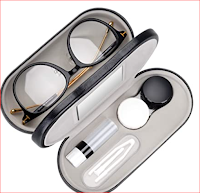In all my talk about upping my daily fiber intake, I think I've only really mentioned bread. Every eating regime needs variety and it's literally true that man cannot live by bread alone. Or, at least, this woman can't.
(Speaking of bread, though: I anxiously await my bread machine (thanks, oh family of mine!) and cannot wait to start exploring recipes.)
As I try moving more toward a 90/10 plant-based regimen, I am trying different beans. I really do love beans but have limited myself to pinto and navy beans for the most part. I don't like dry-tasting beans and I can live without black-eyed peas. Thankfully, there are a lot of varieties of beans to try.
The first "new" beans I tried were the black beans from Faraon. (I read lots of info about the benefits of black beans.)When I soaked these overnight (as I tend to do with all my beans), I was shocked at the deep purple/black of the water. I wondered if I had gotten sham beans that had been dyed to indicated a healthier color! Nope. That is common for these beans. For as much of the color that washed off in the soak, there was still a deep black color to the soup that cooked off the beans. The color actually adds to the appeal. It's certainly not boring.
Here is the nutritional label on the Faraon Beans I got from Amazon.
Here is the recipe for the way I cooked the beans (pretty much the same as I cook pinto beans):
BLACK BEANS
- Soak beans overnight (at least 10 hours) in cold water (in the fridge)
- Drain the water, put the beans in a pot with fresh water (at least 3 inches above the beans).
- Do NOT add salt or salty seasonings until beans have cooked at least an hour or almost finished cooking. Apparently, adding salt slows the softening of the beans.
- Let the beans boil for a few minutes, then turn them down to just a strong simmer, checking every half an hour. (NOTE: I keep a second, smaller pot of water heated on low to add to the beans if they start drying out.)
- Once the beans are on simmer, add a little bit of olive oil (I add about a teaspoon for every dry cup I'm cooking) and add onions and garlic pieces. Some people use different seasonings like bay leaves, thyme, etc.
- Check the water level and texture of the beans about every 30 minutes. Add the other hot water as needed. Don't add too much at a time; you don't want the finished beans to be too watery. They will take anywhere from 2 hours to 2 1/2 hours to cook. (The longer they have been pre-soaked, the sooner they will finish cooking.)
- Don't forget to add any salty seasonings when they are near finished.
The taste of the black beans is so nice. They have the creamy tasted I read about when looking up information. Creamy and smooth. I was able to eat these beans with cornbread just the same as I do with pinto beans. Yummy and extremely filling. I can see why people like eating these beans with rice, but I don't want to add any more starch to my diet if I can help it.
Here's my basic cornbread recipe as remembered from how my mom used to make it:
BASIC CORNBREAD
- Using a cast-iron or oven-safe skillet or baking pan (I use a 9.5-inch cast iron skillet), add a tablespoon of butter to the skillet or pan. Either use melted butter or let it melt by sitting the pan on a low-heat stove. Heat stove to 450 degrees.
- In a bowl, mix the dry ingredients:
- 1 1/2 cup of yellow cornmeal
- 1 cup all-purpose flour
- 2 tsp of baking powder
- 1 tsp table salt
- 1 1/2 Tbl of sugar
- Add to the dry ingredients and just mix enough to combine everything (I like to mix cornbread with a wooden spoon):
- 1 cup of milk (I use whole milk)
- A lightly beaten egg
- 1/4 cup of oil (I use vegetable or canola)
- Pour the batter into the center of the skillet, then using a spoon, scoop some of the butter from the sides onto the center of the batter.
- Depending on the size and depth of the pan, bake from 15 to 25 minutes, until a toothpick comes out of the center cleanly. Edges might be very brown.
 |
| Oven-baked cornbread in a cast-iron skillet |
By the way, this odd-looking thing on the pot of beans is one of those "spill-stopper" lids.
 |
| PureGenius boil-over spill-stopper lid |
Even though I had low expectations, I have to say that I am thrilled with the way this one works. It really did save me from a nasty spill-over when I got yakking on the phone and forgot to check the beans. Thanks to the contrast of colors on the lid, you can easily see the black of the bean juice.
Next time, I will talk about the small red beans and pink beans. I have no idea what to expect from the pink beans!
Peace
--Free





















